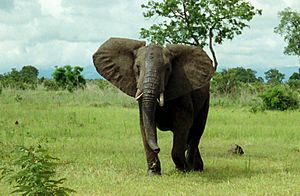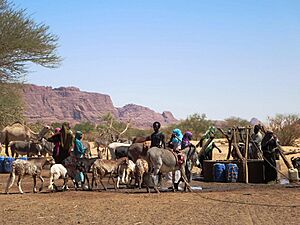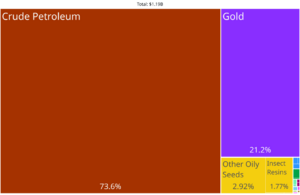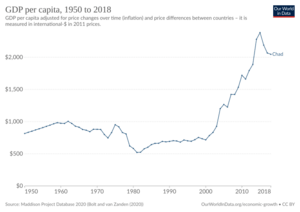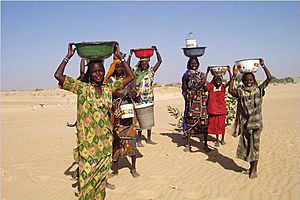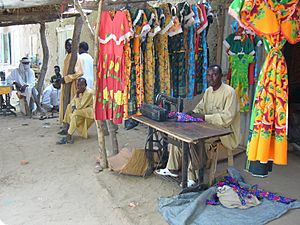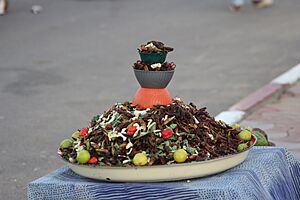Chad facts for kids
Quick facts for kids
Republic of Chad
|
|
|---|---|
|
|
|
|
Anthem:
|
|
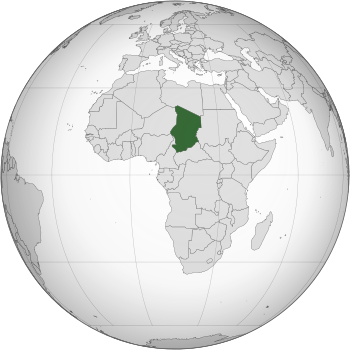 |
|
| Capital and largest city
|
N'Djamena 12°06′N 16°02′E / 12.100°N 16.033°E |
| Official languages | |
| Ethnic groups
(2009 Census)
|
|
| Religion
(2020)
|
|
| Demonym(s) | Chadian |
| Government | Unitary semi-presidential republic under a military junta |
| Mahamat Déby | |
| Succès Masra | |
|
• Vice President
|
Djimadoum Tiraina |
| Legislature | National Transitional Council |
| Independence from France | |
|
• Colony established
|
5 September 1900 |
|
• Autonomy granted
|
28 November 1958 |
|
• Sovereign state
|
11 August 1960 |
| Area | |
|
• Total
|
1,284,000 km2 (496,000 sq mi) (20th) |
|
• Water (%)
|
1.9 |
| Population | |
|
• 2024 estimate
|
19,093,595 (66th) |
|
• Density
|
14.4/km2 (37.3/sq mi) |
| GDP (PPP) | 2023 estimate |
|
• Total
|
|
|
• Per capita
|
|
| GDP (nominal) | 2023 estimate |
|
• Total
|
|
|
• Per capita
|
|
| Gini (2018) | 37.5 medium |
| HDI (2022) | low · 189th |
| Currency | Central African CFA franc (XAF) |
| Time zone | UTC+1 (WAT) |
| Driving side | right |
| Calling code | +235 |
| ISO 3166 code | TD |
| Internet TLD | .td |
Chad ( chad), officially the Republic of Chad, is a landlocked country at the crossroads of North and Central Africa. It is bordered by Libya to the north, Sudan to the east, the Central African Republic to the south, Cameroon to the southwest, Nigeria to the southwest (at Lake Chad), and Niger to the west. Chad has a population of 16 million, of which 1.6 million live in the capital and largest city of N'Djamena.
Chad has several regions: a desert zone in the north, an arid Sahelian belt in the centre and a more fertile Sudanian Savanna zone in the south. Lake Chad, after which the country is named, is the second-largest wetland in Africa. Chad's official languages are Arabic and French. It is home to over 200 different ethnic and linguistic groups. Islam (55.1%) and Christianity (41.1%) are the main religions practiced in Chad.
Beginning in the 7th millennium BC, human populations moved into the Chadian basin in great numbers. By the end of the 1st millennium AD, a series of states and empires had risen and fallen in Chad's Sahelian strip, each focused on controlling the trans-Saharan trade routes that passed through the region. France conquered the territory by 1920 and incorporated it as part of French Equatorial Africa. In 1960, Chad obtained independence under the leadership of François Tombalbaye. Resentment towards his policies in the Muslim north culminated in the eruption of a long-lasting civil war in 1965. In 1979 the rebels conquered the capital and put an end to the South's hegemony. The rebel commanders then fought amongst themselves until Hissène Habré defeated his rivals. The Chadian–Libyan conflict erupted in 1978 by the Libyan invasion which stopped in 1987 with a French military intervention (Operation Épervier). Hissène Habré was overthrown in turn in 1990 by his general Idriss Déby. With French support, a modernization of the Chad National Army was initiated in 1991. From 2003, the Darfur crisis in Sudan spilt over the border and destabilised the nation. Already poor, the nation and people struggled to accommodate the hundreds of thousands of Sudanese refugees who live in and around camps in eastern Chad.
While many political parties participated in Chad's legislature, the National Assembly, power laid firmly in the hands of the Patriotic Salvation Movement during the presidency of Idriss Déby, whose rule was described as authoritarian. After President Déby was killed by FACT rebels in April 2021, the Transitional Military Council led by his son Mahamat Déby assumed control of the government and dissolved the Assembly. Chad remains plagued by political violence and recurrent attempted coups d'état.
Chad ranks the 2nd lowest in the Human Development Index, with 0.394 in 2021 placed 190th, and a least developed country facing the effects of being one of the poorest and most corrupt countries in the world. Most of its inhabitants live in poverty as subsistence herders and farmers. Since 2003 crude oil has become the country's primary source of export earnings, superseding the traditional cotton industry. Chad has a poor human rights record, with frequent abuses and limits on civil liberties by both security forces and armed militias.
Contents
Geography
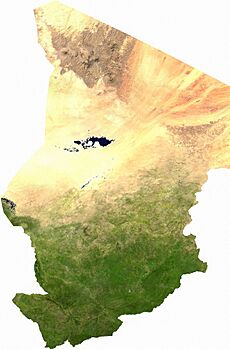
Chad is a large landlocked country spanning north-central Africa. It covers an area of 1,284,000 square kilometres (496,000 sq mi), lying between latitudes 7° and 24°N, and 13° and 24°E, and is the twentieth-largest country in the world. Chad is, by size, slightly smaller than Peru and slightly larger than South Africa.
Chad is bounded to the north by Libya, to the east by Sudan, to the west by Niger, Nigeria and Cameroon, and to the south by the Central African Republic. The country's capital is 1,060 kilometres (660 mi) from the nearest seaport, Douala, Cameroon. Because of this distance from the sea and the country's largely desert climate, Chad is sometimes referred to as the "Dead Heart of Africa".
The dominant physical structure is a wide basin bounded to the north and east by the Ennedi Plateau and Tibesti Mountains, which include Emi Koussi, a dormant volcano that reaches 3,414 metres (11,201 ft) above sea level. Lake Chad, after which the country is named (and which in turn takes its name from the Kanuri word for "lake"), is the remains of an immense lake that occupied 330,000 square kilometres (130,000 sq mi) of the Chad Basin 7,000 years ago. Although in the 21st century it covers only 17,806 square kilometres (6,875 sq mi), and its surface area is subject to heavy seasonal fluctuations, the lake is Africa's second largest wetland.
Chad is home to six terrestrial ecoregions: East Sudanian savanna, Sahelian Acacia savanna, Lake Chad flooded savanna, East Saharan montane xeric woodlands, South Saharan steppe and woodlands, and Tibesti-Jebel Uweinat montane xeric woodlands. The region's tall grasses and extensive marshes make it favourable for birds, reptiles, and large mammals. Chad's major rivers—the Chari, Logone and their tributaries—flow through the southern savannas from the southeast into Lake Chad.
Each year a tropical weather system known as the intertropical front crosses Chad from south to north, bringing a wet season that lasts from May to October in the south, and from June to September in the Sahel. Variations in local rainfall create three major geographical zones. The Sahara lies in the country's northern third. Yearly precipitations throughout this belt are under 50 millimetres (2.0 in); only occasional spontaneous palm groves survive, all of them south of the Tropic of Cancer.
The Sahara gives way to a Sahelian belt in Chad's centre; precipitation there varies from 300 to 600 mm (11.8 to 23.6 in) per year. In the Sahel, a steppe of thorny bushes (mostly acacias) gradually gives way to the south to East Sudanian savanna in Chad's Sudanese zone. Yearly rainfall in this belt is over 900 mm (35.4 in).
Wildlife
Chad's animal and plant life correspond to the three climatic zones. In the Saharan region, the only flora is the date-palm groves of the oasis. Palms and acacia trees grow in the Sahelian region. The southern, or Sudanic, zone consists of broad grasslands or prairies suitable for grazing. As of 2002[update] there were at least 134 species of mammals, 509 species of birds (354 species of residents and 155 migrants), and over 1,600 species of plants throughout the country.
Elephants, lions, buffalo, hippopotamuses, rhinoceroses, giraffes, antelopes, leopards, cheetahs, hyenas, and many species of snakes are found here, although most large carnivore populations have been drastically reduced since the early 20th century. Elephant poaching, particularly in the south of the country in areas such as Zakouma National Park, is a severe problem. The small group of surviving West African crocodiles in the Ennedi Plateau represents one of the last colonies known in the Sahara today.
Chad had a 2018 Forest Landscape Integrity Index mean score of 6.18/10, ranking it 83rd globally out of 172 countries. Extensive deforestation has resulted in loss of trees such as acacias, baobab, dates and palm trees. This has also caused loss of natural habitat for wild animals; one of the main reasons for this is also hunting and livestock farming by increasing human settlements. Populations of animals like lions, leopards and rhino have fallen significantly.
Efforts have been made by the Food and Agriculture Organization to improve relations between farmers, agro-pastoralists and pastoralists in the Zakouma National Park (ZNP), Siniaka-Minia, and Aouk reserve in southeastern Chad to promote sustainable development. As part of the national conservation effort, more than 1.2 million trees have been replanted to check the advancement of the desert, which incidentally also helps the local economy by way of financial return from acacia trees, which produce gum arabic, and also from fruit trees.
Poaching is a serious problem in the country, particularly of elephants for the profitable ivory industry and a threat to lives of rangers even in the national parks such as Zakouma. Elephants are often massacred in herds in and around the parks by organized poaching. The problem is worsened by the fact that the parks are understaffed.
Demographics
Chad's national statistical agency projected the country's 2015 population between 13,630,252 and 13,679,203, with 13,670,084 as its medium projection; based on the medium projection, 3,212,470 people lived in urban areas and 10,457,614 people lived in rural areas. The country's population is young: an estimated 47% is under 15. The birth rate is estimated at 42.35 births per 1,000 people, and the mortality rate at 16.69. The life expectancy is 52 years. The agency assessed the population as at mid 2017 at 15,775,400, of whom just over 1.5 million were in N'Djaména.
Chad's population is unevenly distributed. Density is 0.1/km2 (0.26/sq mi) in the Saharan Borkou-Ennedi-Tibesti Region but 52.4/km2 (136/sq mi) in the Logone Occidental Region. In the capital, it is even higher. About half of the nation's population lives in the southern fifth of its territory, making this the most densely populated region.
Urban life is concentrated in the capital, whose population is mostly engaged in commerce. The other major towns are Sarh, Moundou, Abéché and Doba, which are considerably smaller but growing rapidly in population and economic activity. Since 2003, 230,000 Sudanese refugees have fled to eastern Chad from war-ridden Darfur. With the 172,600 Chadians displaced by the civil war in the east, this has generated increased tensions among the region's communities.
Largest cities, towns, and municipalities
| Rank | City | Population | Region | |
|---|---|---|---|---|
| 1993 Census | 2009 Census | |||
| 1. | N'Djaména | 530,965 | 951,418 | N'Djaména |
| 2. | Moundou | 99,530 | 137,251 | Logone Occidental |
| 3. | Abéché | 54,628 | 97,963 | Ouaddaï |
| 4. | Sarh | 75,496 | 97,224 | Moyen-Chari |
| 5. | Kélo | 31,319 | 57,859 | Tandjilé |
| 6. | Am Timan | 21,269 | 52,270 | Salamat |
| 7. | Doba | 17,920 | 49,647 | Logone Oriental |
| 8. | Pala | 26,116 | 49,461 | Mayo-Kebbi Ouest |
| 9. | Bongor | 20,448 | 44,578 | Mayo-Kebbi Est |
| 10. | Goz Beïda | 3,083 | 41,248 | Sila |
Ethnic groups
The peoples of Chad carry significant ancestry from Eastern, Central, Western, and Northern Africa.
Chad has more than 200 distinct ethnic groups, which create diverse social structures. The colonial administration and independent governments have attempted to impose a national society, but for most Chadians the local or regional society remains the most important influence outside the immediate family. Nevertheless, Chad's people may be classified according to the geographical region in which they live.
In the south live sedentary people such as the Sara, the nation's main ethnic group, whose essential social unit is the lineage. In the Sahel sedentary peoples live side by side with nomadic ones, such as the Arabs, the country's second major ethnic group. The north is inhabited by nomads, mostly Toubous.
Languages
Chad's official languages are Arabic and French, but over 100 languages are spoken. The Chadic branch of the Afroasiatic language family gets its name from Chad, and is represented by dozens of languages native to the country. Chad is also home to Central Sudanic, Maban, and several Niger-Congo languages.
Due to the important role played by itinerant Arab traders and settled merchants in local communities, Chadian Arabic has become a lingua franca.
Religion
Chad is a religiously diverse country. Various estimates, including from Pew Research Center in 2010, found that 52–58% of the population was Muslim, while 39–44% were Christian, with 22% being Catholic and a further 17% being Protestant. According to a 2012 Pew Research survey, 48% of Muslim Chadians professed to be Sunni, 21% Shia, 4% Ahmadi and 23% non-denominational Muslim. Islam is expressed in diverse ways; for example, 55% of Muslim Chadians belong to Sufi orders. Its most common expression is the Tijaniyah, an order followed by the 35% of Chadian Muslims which incorporates some local African religious elements. In 2020, the ARDA estimated the vast majority of Muslims Chadians to be Sunni belonging to the Sufi brotherhood Tijaniyah. A small minority of the country's Muslims (5–10%) hold more fundamentalist practices, which, in some cases, may be associated with Saudi-oriented Salafi movements.
Roman Catholics represent the largest Christian denomination in the country. Most Protestants, including the Nigeria-based "Winners' Chapel", are affiliated with various evangelical Christian groups. Members of the Baháʼí and Jehovah's Witnesses religious communities also are present in the country. Both faiths were introduced after independence in 1960 and therefore are considered to be "new" religions in the country.
A small proportion of the population continues to practice indigenous religions. Animism includes a variety of ancestor and place-oriented religions whose expression is highly specific. Christianity arrived in Chad with the French and American missionaries; as with Chadian Islam, it syncretises aspects of pre-Christian religious beliefs.
Administrative divisions
Since 2012 Chad has been divided into 23 regions. The subdivision of Chad in regions came about in 2003 as part of the decentralisation process, when the government abolished the previous 14 prefectures. Each region is headed by a presidentially appointed governor. Prefects administer the 61 departments within the regions. The departments are divided into 200 sub-prefectures, which are in turn composed of 446 cantons.
The cantons are scheduled to be replaced by communautés rurales, but the legal and regulatory framework has not yet been completed. The constitution provides for decentralised government to compel local populations to play an active role in their own development. To this end, the constitution declares that each administrative subdivision be governed by elected local assemblies, but no local elections have taken place, and communal elections scheduled for 2005 have been repeatedly postponed.
| No. | Region | Pop'n (2009) |
Pop'n (1 July 2023) |
Est. Area (km2) |
Capital | Departments |
|---|---|---|---|---|---|---|
| 1 | Batha | 488,458 | 748,395 | 93,732 | Ati | Batha Est, Batha Ouest, Fitri |
| 22 | Chari-Baguirmi | 578,425 | 884,924 | 47,226 | Massenya | Baguirmi, Chari, Loug Chari |
| 23 | Hadjer-Lamis | 566,858 | 870,231 | 31,376 | Massakory | Dababa, Dagana , Haraze Al Biar |
| 5 | Wadi Fira | 508,383 | 792,394 | 56,362 | Biltine | Biltine, Dar Tama, Kobé |
| 2 | Bahr el Gazel | 257,267 | 407,256 | 58,525 | Moussoro | Barh El Gazel Nord, Barh El Gazel Sud |
| 3 | Borkou | 93,584 | 154,865 | 271,513 | Faya-Largeau | Borkou, Borkou Yala |
| 8 | Ennedi-Est | 107,302 | 175,321 | 81,696 | Am-Djarass | Am-Djarass, Wadi Hawar |
| 12 | Ennedi-Ouest | 60,617 | 109,753 | 117,686 | Fada | Fada, Mourtcha |
| 9 | Guéra | 538,359 | 824,161 | 62,678 | Mongo | Abtouyour, Barh Signaka, Guéra, Mangalmé |
| 13 | Kanem | 333,387 | 505,839 | 70,516 | Mao | Kanem, Nord Kanem, Wadi Bissam |
| 14 | Lac | 331,496 | 509,258 | 20,543 | Bol | Mamdi, Wayi |
| 11 | Logone Occidental | 689,044 | 1,053,958 | 8,969 | Moundou | Dodjé, Guéni, Lac Wey, Ngourkosso |
| 7 | Logone Oriental | 779,339 | 1,184,567 | 24,119 | Doba | La Nya, La Nya Pendé, La Pendé, Kouh-Est, Kouh-Ouest, Monts de Lam |
| 15 | Mandoul | 628,065 | 1,002,346 | 17,761 | Koumra | Barh Sara, Mandoul Occidental, Mandoul Oriental |
| 6 | Mayo-Kebbi Est | 774,782 | 1,179,260 | 18,458 | Bongor | Kabbia, Mayo-Boneye, Mayo-Lémié, Mont d'Illi |
| 10 | Mayo-Kebbi Ouest | 564,470 | 858,593 | 12,787 | Pala | Lac Léré, Mayo-Dallah |
| 19 | Moyen-Chari | 588,008 | 902,311 | 42,307 | Sarh | Barh Kôh, Grande Sido, Lac Iro |
| 4 | Ouaddaï | 721,166 | 1,102,467 | 30,790 | Abéché | Abdi, Assoungha, Ouara |
| 17 | Salamat | 302,301 | 470,256 | 69,631 | Am Timan | Aboudeïa, Barh Azoum, Haraze-Mangueigne |
| 18 | Sila | 387,461 | 591,300 | 36,745 | Goz Beïda | Djourf Al Ahmar, Kimiti |
| 20 | Tandjilé | 661,906 | 1,007,812 | 17,891 | Laï | Tandjilé Est, Tandjilé Ouest |
| 21 | Tibesti | 25,483 | 52,626 | 135,896 | Bardaï | Tibesti Est, Tibesti Ouest |
| 16 | N'Djamena (capital) | 951,418 | 1,434,592 | 408 | N'Djamena | 10 dawāʾir or arrondissements |
Economy
The United Nations' Human Development Index ranks Chad as the seventh poorest country in the world, with 80% of the population living below the poverty line. The GDP (purchasing power parity) per capita was estimated as US$1,651 in 2009. Chad is part of the Bank of Central African States, the Customs and Economic Union of Central Africa (UDEAC) and the Organization for the Harmonization of Business Law in Africa (OHADA).
Chad's currency is the CFA franc. In the 1960s, the mining industry of Chad produced sodium carbonate, or natron. There have also been reports of gold-bearing quartz in the Biltine Prefecture. However, years of civil war have scared away foreign investors; those who left Chad between 1979 and 1982 have only recently begun to regain confidence in the country's future. In 2000 major direct foreign investment in the oil sector began, boosting the country's economic prospects.
Uneven inclusion in the global political economy as a site for colonial resource extraction (primarily cotton and crude oil), a global economic system that does not promote nor encourage the development of Chadian industrialization, and the failure to support local agricultural production has meant that the majority of Chadians live in daily uncertainty and hunger. Over 80% of Chad's population relies on subsistence farming and livestock raising for its livelihood. The crops grown and the locations of herds are determined by the local climate. In the southernmost 10% of the territory lies the nation's most fertile cropland, with rich yields of sorghum and millet. In the Sahel only the hardier varieties of millet grow, and with much lower yields than in the south. On the other hand, the Sahel is ideal pastureland for large herds of commercial cattle and for goats, sheep, donkeys and horses. The Sahara's scattered oases support only some dates and legumes. Chad's cities face serious difficulties of municipal infrastructure; only 48% of urban residents have access to potable water and only 2% to basic sanitation.
Before the development of oil industry, cotton dominated industry and the labour market accounted for approximately 80% of export earnings. Cotton remains a primary export, although exact figures are not available. Rehabilitation of Cotontchad, a major cotton company weakened by a decline in world cotton prices, has been financed by France, the Netherlands, the European Union, and the International Bank for Reconstruction and Development (IBRD). The parastatal is now expected to be privatised. Other than cotton, cattle and gum arabic are dominant.
Chad has made some progress in reducing poverty, there was a decline in the national poverty rate from 55% to 47% between 2003 and 2011. However, the amount of poor people increased from 4.7 million (2011) to 6.5 million (2019) in absolute amounts. By 2018, 4.2 out of 10 people still live below the poverty line.
Culture
Because of its great variety of peoples and languages, Chad possesses a rich cultural heritage. The Chadian government has actively promoted Chadian culture and national traditions by opening the Chad National Museum and the Chad Cultural Centre. Six national holidays are observed throughout the year, and movable holidays include the Christian holiday of Easter Monday and the Muslim holidays of Eid ul-Fitr, Eid ul-Adha, and Eid Milad Nnabi.
Cuisine
Millet is the staple food of Chadian cuisine. It is used to make balls of paste that are dipped in sauces. In the north this dish is known as alysh; in the south, as biya. Fish is popular, which is generally prepared and sold either as salanga (sun-dried and lightly smoked Alestes and Hydrocynus) or as banda (smoked large fish). Carcaje is a popular sweet red tea extracted from hibiscus leaves. Alcoholic beverages, though absent in the north, are popular in the south, where people drink millet beer, known as billi-billi when brewed from red millet, and as coshate when from white millet.
Music
The music of Chad includes a number of instruments such as the kinde, a type of bow harp; the kakaki, a long tin horn; and the hu hu, a stringed instrument that uses calabashes as loudspeakers. Other instruments and their combinations are more linked to specific ethnic groups: the Sara prefer whistles, balafons, harps and kodjo drums; and the Kanembu combine the sounds of drums with those of flute-like instruments.
The music group Chari Jazz formed in 1964 and initiated Chad's modern music scene. Later, more renowned groups such as African Melody and International Challal attempted to mix modernity and tradition. Popular groups such as Tibesti have clung faster to their heritage by drawing on sai, a traditional style of music from southern Chad. The people of Chad have customarily disdained modern music. However, in 1995 greater interest has developed and fostered the distribution of CDs and audio cassettes featuring Chadian artists. Piracy and a lack of legal protections for artists' rights remain problems to further development of the Chadian music industry.
Literature
As in other Sahelian countries, literature in Chad has seen an economic, political and spiritual drought that has affected its best known writers. Chadian authors have been forced to write from exile or expatriate status and have generated literature dominated by themes of political oppression and historical discourse. Since 1962, 20 Chadian authors have written some 60 works of fiction. Among the most internationally renowned writers are Joseph Brahim Seïd, Baba Moustapha, Antoine Bangui and Koulsy Lamko. In 2003 Chad's sole literary critic, Ahmat Taboye, published his Anthologie de la littérature tchadienne to further knowledge of Chad's literature internationally and among youth and to make up for Chad's lack of publishing houses and promotional structure.
Sports
Football is Chad's most popular sport. The country's national team is closely followed during international competitions and Chadian footballers have played for French teams. Basketball and freestyle wrestling are widely practiced, the latter in a form in which the wrestlers put on traditional animal hides and cover themselves with dust.
Images for kids
-
Group of Kanem-Bu warriors. The Kanem–Bornu Empire controlled almost all of what is today Chad.
-
A Chadian soldier fighting for Free France during World War II. The Free French Forces included 15,000 soldiers from Chad.
-
Despite internal political opposition, coup attempts, and a civil war, Idriss Déby continuously ruled Chad from 1990 until his death in 2021.
See also
 In Spanish: Chad para niños
In Spanish: Chad para niños




